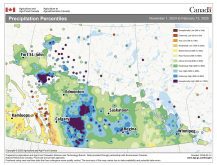Industry thinks the proposed Clean Fuel Standard could unleash demand that would require two or three new crushers
Canada could see a second wave of canola crush plant construction if Ottawa gets its proposed Clean Fuel Standard right, says an industry spokesperson.
Chris Vervaet, executive director of the Canadian Oilseed Processors Association, said renewable diesel and biodiesel consumption could reach three million litres per year by 2030 under the CFS.
That would require an additional 1.5 million tonnes of canola oil annually.
“We’re talking about at least the need for two to three new (crush) plants to meet that demand,” he said during a presentation at Canola Week 2020.
Read Also

VIDEO: Ag in Motion documentary launches second season
The second season of the the Western Producer’s documentary series about Ag in Motion launched Oct. 8.
The last time there was a building bonanza like that was a decade ago when Richardson International and Louis Dreyfus christened new plants in Yorkton, Sask., and Cargill doubled the capacity of its plant in Clavet, Sask.
“We really do see potential in the Clean Fuel Standard to replicate what we see unfolding in the United States,” said Vervaet.
He is referring to California’s Low Carbon Fuel Standard, which is leading to an “explosion” in biodiesel and renewable diesel consumption.
“What we see happening in the U.S. is quite remarkable and I like to characterize it as a biofuel renaissance,” said Vervaet.
“Biofuels are being blended into diesel at remarkable volumes.”
Biodiesel and renewable diesel consumption in the U.S. has more than doubled over the last decade and that is just the beginning.
Renewable diesel production is expected to triple or quadruple over the next three to four years as companies scramble to meet the California demand.
There is currently no approved pathway for canola to be used as a renewable diesel feedstock in the U.S.
The Canola Council of Canada is working with U.S. regulators to address that market access issue, said Vervaet.
In the meantime, he is hopeful that the CFS will lead to a similar Canadian renaissance for the biofuel sector.
The canola industry will be looking for two key elements in the fine print of the CFS. Canola production must be deemed sustainable on an aggregate basis. And canola’s low carbon advantages must be reflected in the government’s life cycle analysis model.
Regulations for the liquid fuel class of the standard will be finalized in late 2021 and are scheduled to come into force in 2022.
Canada will crush an estimated 10 million tonnes of canola in 2020. The council’s target is 14 million tonnes of crush by 2025. The CFS could help the industry meet that target.
Brittany Dyck, senior manager of canola utilization with the council, said 14 million tonnes of crush would result in an additional two million tonnes of canola meal production.
The U.S. and China account for 99 percent of Canada’s canola meal exports.
Sales to China have been coming on strong. It now accounts for about one-quarter of Canada’s exports, stealing supplies away from the U.S.
Canola meal is primarily used in aquaculture feed in China. There is very little consumed by the dairy industry, which represents an opportunity to increase sales.
California’s dairy industry is by far the biggest market in the U.S., consuming about 1.3 million tonnes per year.
Dairy producers can get an extra litre of milk per cow per day by incorporating canola meal in their rations. New research suggests they can get even more production by increasing use during certain stages of production.
Studies show canola meal can decrease cattle methane emissions and result in less nitrogen excretion.
Dyck said research has also debunked the myth that canola meal is dangerous to feed to other livestock species.
The other emerging opportunity for canola meal is as a protein ingredient in human foods.


















